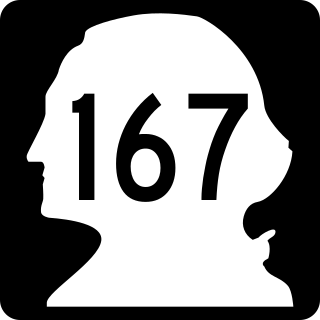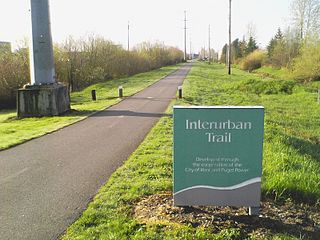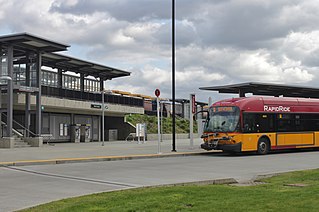
Pierce County is a county in the U.S. state of Washington. As of the 2020 census, the population was 921,130, up from 795,225 in 2010, making it the second-most populous county in Washington, behind King County, and the 59th-most populous in the United States. The county seat and largest city is Tacoma. Formed out of Thurston County on December 22, 1852, by the legislature of Oregon Territory, it was named for U.S. President Franklin Pierce. Pierce County is in the Seattle metropolitan area.

Tukwila is a suburban city in King County, Washington, United States, located immediately to the south of Seattle. The population was 21,798 at the 2020 census.

Edgewood is a city in Pierce County, Washington, United States. The population was 12,327 at the 2020 census. Neighboring towns include Fife to the west, Milton to the northwest, Federal Way to the north, Sumner to the east, and Puyallup to the south.

Midland is a census-designated place (CDP) in Pierce County, Washington. The population was 9,962 at the time of the 2020 census.

The Seattle and Walla Walla Railroad was a 3 ft narrow gauge railroad and was the first proper railroad to serve Seattle, Washington, preceded only by horse-drawn rail vehicles and by a coal train making the very short haul from Lake Union to Pike Street. Despite its ambitious name, actual construction never went beyond King County, the county of which Seattle itself is the seat. After being sold to Henry Villard's Oregon Improvement Company in 1880 it was renamed the Columbia and Puget Sound Railroad. In 1916, that became the Pacific Coast Railroad Company.

The Green River is a 65-mile (105 km) long river in the state of Washington in the United States, arising on the western slopes of the Cascade Range south of Interstate 90.

State Route 167 (SR 167) is a state highway in the Seattle metropolitan area of Washington state. It is commonly known as the Valley Freeway and serves the Green River Valley from Tacoma to Renton, primarily as a four-lane freeway. The 28-mile (45 km) highway begins in Tacoma at an interchange with Interstate 5 (I-5) and travels southeast to Puyallup as an undivided road. It then turns northeast onto a freeway and passes through interchanges with SR 512 in Puyallup and SR 410 in Sumner, continuing north through Auburn and Kent. After an interchange with I-405 in Renton, it terminates at an intersection with SR 900.

Area code 253 is a telephone area code in the North American Numbering Plan (NANP) for a part of the U.S. state of Washington. The numbering plan area (NPA) includes cities in King County that are situated south of Seattle and the southern Puget Sound area, centered at Tacoma and extending to include the areas around Gig Harbor, Auburn, and Roy. It also serves the western half of Pierce County, as well as southern King County.

The Foothills Trail is a mostly paved non-motorized rail-trail in east Pierce County, Washington, extending uninterrupted for 21 miles (34 km) from Puyallup, Washington through Orting and South Prairie, and terminating in Buckley. The trail is used by cyclists, walkers, joggers, inline skaters, and horse riders. Listed as Foothills Regional Trail, it was designated a National Recreation Trail in 2012.

The Interurban Trail are a pair of trails in Washington. The interurban Trail North is a bicycle route running from Downtown Seattle through Shoreline and to the Snohomish County, Washington line. The Interurban Trail South is a rail trail in King and Pierce counties.
The Woodinville Subdivision was a railroad line that was formerly owned by BNSF Railway. It takes its name from one of its original end points in Woodinville, Washington, United States. The line extended approximately 42 miles (68 km) in east King County and Snohomish County. The line's ownership was transferred in a deal involving King County and the Port of Seattle. After BNSF discontinuation of service, the section from Snohomish to Woodinville was operated under contract by Eastside Rail Freight, owned by Ballard Terminal Railroad and Meeker Southern. As of 2024, the line is officially railbanked as decided by the Surface Transportation Board.

Tukwila station is a train station in Tukwila, Washington, United States. The station was built by Sound Transit to serve its Sounder commuter rail service on the S Line, as well as Amtrak's intercity Cascades line. It includes 390 parking spaces and a bus platform served by King County Metro's RapidRide F Line and other routes.

Kent station is a train station in the city of Kent, Washington, United States, served by the S Line of the Sounder commuter rail network. It is located in downtown Kent and consists of two train platforms connected via a pedestrian overpass, a parking garage, and several bus bays. The station also has 996 parking stalls and is served by King County Metro and Sound Transit Express buses. Train service to Kent began in 2001 and the station's garage opened the following year. King County Metro began service from the bus bays in 2005, after a third phase of construction. Sound Transit plans to build a second parking garage in 2027 to accommodate additional demand at the station.

Auburn station is a train station in the city of Auburn, Washington, United States, served by S Line of the Sounder commuter rail network. It is located southwest of downtown Auburn and consists of two train platforms, a bus station, a parking garage, a public plaza, and a pedestrian bridge. The station has 633 parking spaces and is also served by Sound Transit Express, King County Metro, and Pierce Transit buses. Auburn station opened in 2000 and was built on the site of a former railroad station that was demolished in 1979. The parking garage and pedestrian bridge opened in 2003, and a second parking garage is planned to be built by 2027.
The Puget Sound Shore Railroad and successor Northern Pacific and Puget Sound Shore Railroad built a branch line of the Northern Pacific Railroad between Puyallup and Seattle, Washington, U.S., and partially constructed a line around the east side of Lake Washington to Woodinville.

Washington's 10th congressional district is a congressional district in western Washington. The district is centered on the state capital, Olympia, and includes portions of Thurston and Pierce counties. It was created after the 2010 United States census, which granted Washington an additional congressional seat, bringing the number of seats apportioned to the state up from 9 to 10, and elected Denny Heck as its first member to the United States House of Representatives in the 2012 elections. Marilyn Strickland was elected in 2020 to replace him after he retired to run for Lieutenant Governor.

The Interurban Building, formerly known as the Seattle National Bank Building (1890–1899), the Pacific Block (1899–1930) and the Smith Tower Annex (1930–1977), is a historic office building located at Yesler Way and Occidental Way S in the Pioneer Square neighborhood of Seattle, Washington, United States. Built from 1890 to 1891 for the then recently formed Seattle National Bank, it is one of the finest examples of Richardsonian Romanesque architecture in the Pacific Northwest and has been cited by local architects as one of the most beautiful buildings in downtown Seattle. It was the breakthrough project of young architect John Parkinson, who would go on to design many notable buildings in the Los Angeles area in the late 19th and early 20th century.


















